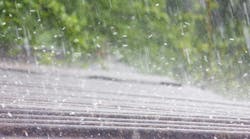About the author: Caitlin Cunningham is managing editor of Storm Water Solutions. Cunningham can be reached at 847.391.1025 or by e-mail at [email protected].
Related search terms from www.waterinfolink.com: climate change, precipitation, flooding
In its recently released report “Increased Flooding Risk: Global Warming’s Wake-Up Call for Riverfront Communities,” the National Wildlife Federation (NWF) outlines the climate change-precipitation connection and urges municipalities to step up their flood prevention and protection efforts. Storm Water Solutions Managing Editor Caitlin Cunningham discussed NWF’s research, predictions and call to action with resident climate scientist Amanda Staudt, Ph.D.
Caitlin Cunningham: NWF predicts an ongoing increase in heavy precipitation events. Please explain.
Amanda Staudt: Global warming is bringing more heavy rainfall events because of the simple fact that warmer air can hold more water. The greater water-carrying capacity of the atmosphere means that more water is accumulating between rainfall events. Then, when it does rain, there is a greater likelihood of a heavy downpour.
The data show a clear increase in heavy rainfall in the U.S. over the past few decades. The most intense rainfall events have been increasing at a rate of 20 percent per 100 years. We are also having more prolonged periods of higher-than-normal precipitation.
Climate models show that this trend will continue. For example, in the Midwest and Northeast, big storms that historically would only be seen once every 20 years are projected to happen as much as every four to six years by the end of the 21st century if global warming pollution is not curbed.
Cunningham: Generally, are U.S. communities prepared for this shift in terms of flood prevention and protections? Why or why not?
Staudt: Some cities have started to account for climate change in their floodplain management, but my guess is that most are not ready. One barrier is that floodplain maps and other planning tools are largely based on historical climate conditions. With good climate projections now available on a regional basis, we must update these maps and planning efforts.
Cunningham: What can cities and states do to reduce their flooding risk?
Staudt: States and communities must take steps to educate those living in the floodplain about their current risk, how changing conditions might affect that risk and steps they can take to prepare. The risks to people living behind levees and below dams should be a priority; government officials should strengthen land-use and building codes in these locations.
New development in flood-prone areas should be discouraged, and the natural systems that help buffer against floods should be protected. In some cases, moving levees back from a river’s edge can take advantage of the natural water storage capacity of the floodplain.
Cunningham: What would you say to those who argue against the climate change phenomenon?
Staudt: The data show that climate is changing, as evidenced by warming air, ocean and land temperatures; melting glaciers and ice caps; rising sea levels; shifting precipitation patterns; and countless changes in natural ecosystems.
Scientists have examined every possible alternative, yet only human-caused emissions of greenhouse gases can explain the trends observed in the past century. Decades of research have led to an unprecedented level of consensus among climate scientists on these findings.
To view NWF’s flooding report, visit www.nwf.org/extremeweather.
Amanda Staudt, Ph.D., is climate scientist for the National Wildlife Federation. Staudt can be reached by e-mail at [email protected].
Download: Here

